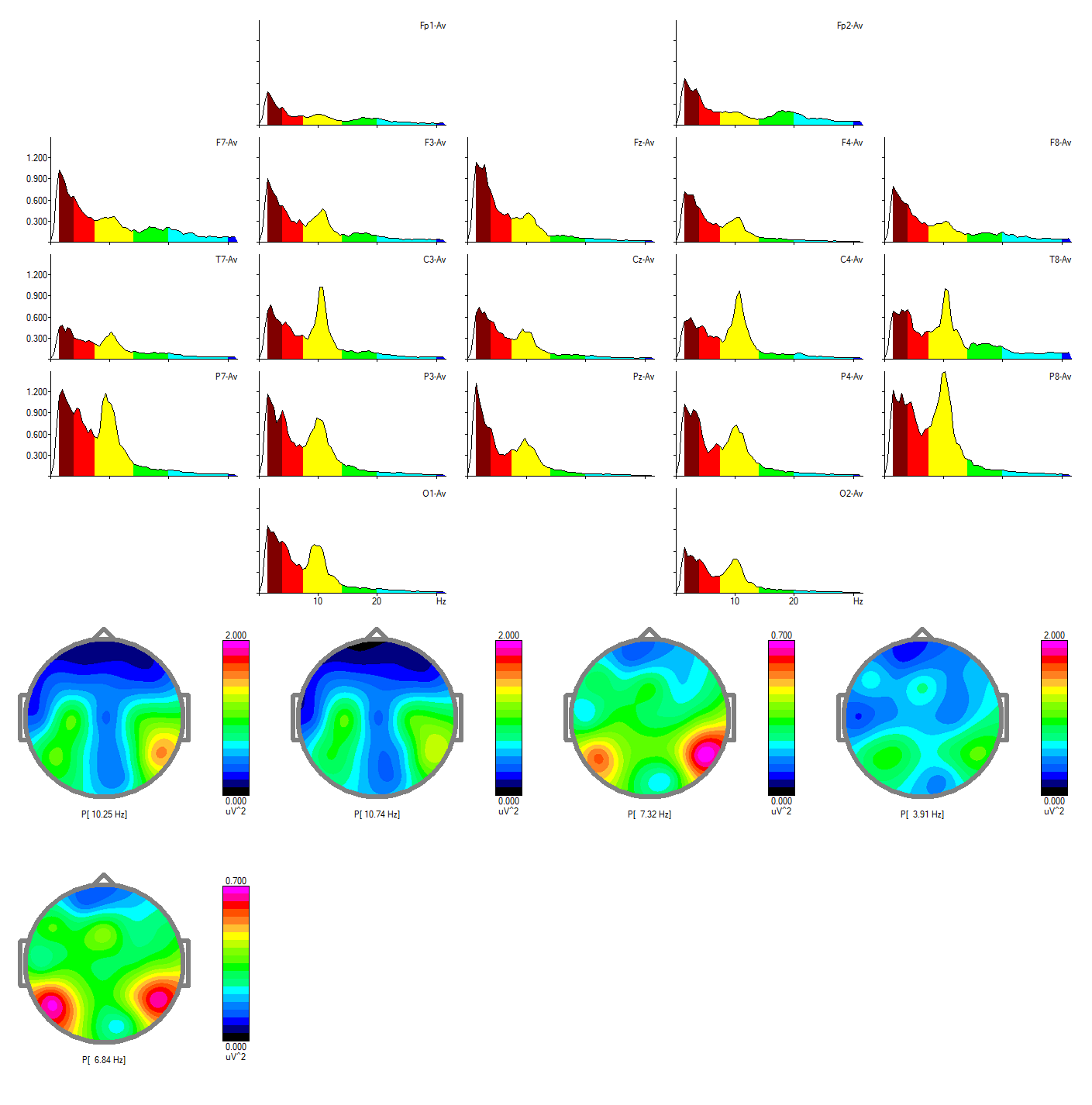
QEEG Brain Mapping
A QEEG or quantitative electroencephalogram is a brain map. It is an electrical measurement, analysis, and quantification of the brainwaves. The brainwaves are the brain’s verbing, or the action potentials of the brain. We first gather the raw EEG data, and then we process it through a normative database, which is a database of healthy individuals’ brainwaves of the same age as the patient. This gives us a comparison of the client’s brain relative to others’. This is the first step in our QEEG assessment process.
The brain mapping process entails placing a soft material cap onto the head of the participant, the cap (shown below) has 21 electrodes or sensors attached. We place gel into the electrodes to help detect microvolts of electrical potentials generated by the brain, this electrical signal shows up as brainwaves and look a lot like squiggles. QEEG or our Neurofeedback training do not put any electrical signals into the brain, they only pick up the signals that are already there,
We then interpret the squiggles in their raw form, as well as run them through many types of digitized filters (i.e. different software), that breaks them into their respective components and brainwave bandwidths of Delta (1-4 Hz), Theta (4-8 Hz), Alpha (8-12 Hz), Low Beta (12-16 Hz), Mid Beta (16-25Hz), Hi Beta (25-40Hz), and Gamma (40-70Hz), they are measured in Hertz or Hz.
Quantitative Electroencephalographic Recording
EEG data is collected using the International 10-20 placement system. Nineteen active electrodes are referenced to linked ear electrodes (see the 10-20 system diagram below). A Nexus-32F acquisition unit with a maximum sampling rate of 2048/sec is used for EEG collection. Below is a bird's-eye view of the electrode positions on the head, with the nose pointing up and the two ears on the side. A1 and A2 are the mastoid (beside the ear) references.
How does QEEG work?
The procedure is a three-part process, which entails:
QEEG recording; includes up to 20 minutes of EEG recording, done with eyes open and eyes closed, the length of time depends on the client and their age.
EEG Analysis and report work up: During this process, we read and understand the "raw data," (the “squiggles” that are the brainwaves). Then, we remove all "artifact" (eye movements, much muscle tension, etc.). The amplitude, frequency and relationships between different areas of the cortex are analyzed then measured statistically by the software and presented — in quantified form — as "brain maps." Your EEG is compared to a reference database of other EEGs.
Delivery of final Quantitative EEG Report.
The report work-up includes the consultation of various cortical and sub-cortical databases and the use of multiple software and brain imaging applications. The final report is approximately 10-15 pages in length, complete with conclusion page, explanatory pictures, graphics, and terminology that is accessible for the layperson, yet true to scientific form. The composition of the report often entails 3-5 hours of additional research.
10 minutes of EEG is acquired in Eyes-Open recording and 10 minutes in the Eyes-Closed recording.
The EEG recordings are then exported to two EEG-processing software platforms: WinEEG v2.127.98.
The imported tracings are visually inspected and artifacted prior to performing further data analysis.
WinEEG processing produces Z-score Absolute Power head maps, in addition to asymmetry maps. This process allows the comparison of the client’s EEG results to an age-matched neurotypical control group. WinEEG utilises Independent Components Analysis (ICA) to detect unique features in the EEG and displays them as global head maps of Fast-Fourier Transforms. Because the WinEEG process demonstrated more episodic and useful elements and events in the EEG for assessment and treatment planning, and because it allows us to acquire much more EEG than the NeuroGuide platform allows, it was determined that the WinEEG results are selected and analysed for reports.
A 45-55 Hz notch filter is used, with a low pass filter of 0.3Hz and a high pass of 50 Hz in the display of the EEG after ICA processing. This is then determined to be a valid and interpretable recording.
All raw EEGs are shown in Global Average (Laplacian) montage.
All recordings are processed with Dr Mary L. Tracy, MA, PhD, MFT, BCN, Director Northern California Neurotherapy.
Through comparison of the WinEEG database of hundreds of others’ EEGs, we are able to determine where the individual is different from the norm. We are able to look not only at the brainwaves, but also the relationship of the brainwaves to one another, the symmetry of the brain, the stability of the brainwave relationships, and the areas where the brain might be generating problematic signals, manifesting in problematic symptoms and behaviours.
This form of assessment provides the roadmap that all training follows.
Eyes-open (EO) EEG Q1
Eyes-Open (EO) Graphs of EEG power spectra
Eyes-open (EO) LORETA for Component
Other ways we can help
-

Initial consultation
In our initial consultation and assessment process, the client meets with one of our licensed mental health care professionals so that we can best determine your needs and explain our process and training modalities in full.
-

Neurofeedback
This is a non-invasive treatment which works toward improving the root source of symptoms. It differs from medicine as it treats the issue at its core, not the symptoms that result.
-

Biofeedback
This is a pioneering process that can enable the control of bodily processes that are normally involuntary, such as muscle tension, blood pressure, or heart rate.
-

Buteyko breathing
Named after Dr Konstantin Buteyko, the Buteyko Method consists of a series of breathing exercises and guidelines specifically designed to reduce over-breathing (clinically known as ‘chronic hyperventilation’)
-

Therapy
Our highly skilled therapists provide a therapeutic approach that focuses on full recovery as opposed to a ‘temporary fix’. It is accessible for children, young people, and adults







